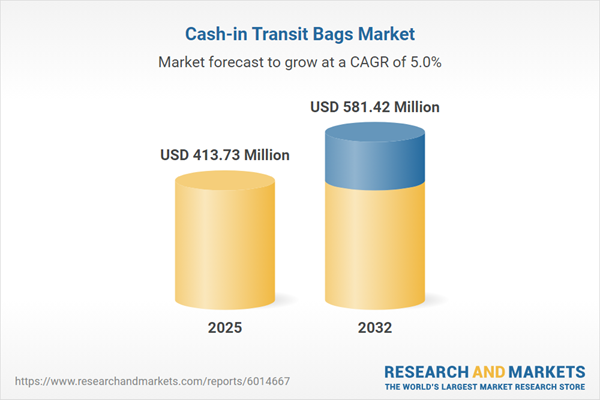Speak directly to the analyst to clarify any post sales queries you may have.
Senior decision-makers require robust, future-ready solutions to secure cash logistics amid rising compliance demands, evolving risks, and stricter global regulations. The cash-in-transit bags market is continuously innovating to support operational resilience and defend against emerging threats to cash movement across industries.
Market Snapshot: Growth and Innovation in the Cash-in-Transit Bags Market
The cash-in-transit bags market is expanding at a steady pace, with a current valuation of USD 394.25 million in 2024, projected to reach USD 413.73 million by 2025 and USD 581.42 million by 2032—a compound annual growth rate of 4.97%.
This growth is driven by widespread adoption from banks, retail providers, and specialized cash management services seeking advanced security. Product innovation now centers on digital integration, advanced tamper-evident features, and updated compliance mechanisms. Industry-leading manufacturers are recalibrating products to balance physical security with workflow agility, aligning their offerings to address regulated cash handling environments and changing stakeholder needs.Scope & Segmentation in the Cash-in-Transit Bags Market
- Material Types: Composite materials like carbon fiber or Kevlar boost durability and impact resistance for secure transit. Technical fabrics such as nylon and polyester offer enhanced usability and lifespan. Advanced polymers, including polyethylene and polypropylene, cater to rigorous high-frequency operations within financial and retail sectors.
- Lock Mechanisms: Advanced electronic locks, including biometric and RFID solutions, automate asset tracking and restrict access to authorized personnel. Mechanical keyed and combination locks maintain familiar protocols, while tamper-evident seals enable instant detection of breach attempts.
- Bag Types: Hard-shell containers are designed for high-value asset routes and bulk transfer protection, minimizing risks in sensitive environments. Soft-shell bags with versatile closures, including zipper and Velcro, support agile workflows in day-to-day cash handling.
- End Users: Central and commercial banks, dedicated cash-in-transit service firms, supermarkets, and shopping centers rely on these solutions to reduce exposure and maintain transactional security.
- Applications: Deployment spans ATM restocking, casino and gaming venues, inter-site fund movement, retail cash deposit logistics, and lottery sector requirements, supporting secure and efficient cash flow management across diverse operational settings.
- Security Levels: Multi-layered security configurations address intricate regulatory and high-risk use cases. Standard security options are matched to routine operational demands, allowing organizations to adapt solutions to their specific risk environment.
- Regions Covered: The market footprint includes the Americas, Europe, the Middle East, Africa, and Asia-Pacific. Notably, China, India, Japan, South Korea, Australia, and Southeast Asia exhibit fast-growing adoption rates, underpinned by regulatory modernization and advancing logistics infrastructure.
- Key Companies Reviewed: Major industry players include International Paper Company, WestRock Company, Berry Global Group, Amcor plc, Smurfit Kappa Group, Mondi plc, Sonoco Products, DS Smith plc, Sealed Air Corporation, and Huhtamaki Oyj, each supporting innovation and global supply chain resilience.
Key Takeaways for Senior Decision-Makers
- Adoption of smart access solutions and automated tracking heightens visibility across the entire cash logistics lifecycle, supporting more effective incident response and auditing.
- Material advances yield enhanced product reliability, helping organizations meet the evolving requirements of compliance-focused environments while adapting to new operational risks.
- Modular and flexible bag designs enable rapid adjustment for both regular operations and elevated risk periods, empowering organizations to align investment and preparedness with enterprise risk strategies.
- Companies are tuning supply chain strategies, with an increasing preference for local and regional suppliers to stabilize material supply, safeguard against disruptions, and better manage volatility from global market shifts.
- Holistic industry approaches—merging security technology, manufacturing expertise, and automation—are enabling tighter process control and compliance standards in cash handling operations.
Tariff Impact: Navigating Trade Disruptions
Adjustments to US tariff schedules have increased costs for critical bag materials and digital components. Industry leaders are strengthening relationships with domestic suppliers and expanding sourcing diversity to help maintain security standards and business continuity as global conditions fluctuate.
Methodology & Data Sources
This report draws on insights from over fifty expert interviews in security, logistics, and materials science. Findings are validated using site inspections, trade and patent records, and peer-reviewed studies to ensure actionable, reliable recommendations for advancing secure cash-in-transit operations.
Why This Report Matters
- Enables leaders to benchmark and refine their cash logistics strategies for security and compliance across diverse regulatory environments.
- Clarifies segmentation and regional trends, improving risk planning and decision-making for organizations operating across global cash-handling networks.
- Demonstrates how material innovation and supply chain reinforcement are shaping the development of secure and compliant cash-in-transit bag solutions for complex operating environments.
Conclusion
With regulatory landscapes evolving, organizations must prioritize advances in cash logistics. This report supplies targeted insights to help senior executives strengthen security and maintain compliance throughout the cash handling lifecycle.
Additional Product Information:
- Purchase of this report includes 1 year online access with quarterly updates.
- This report can be updated on request. Please contact our Customer Experience team using the Ask a Question widget on our website.
Table of Contents
3. Executive Summary
4. Market Overview
7. Cumulative Impact of Artificial Intelligence 2025
Companies Mentioned
The companies profiled in this Cash-in Transit Bags market report include:- International Paper Company
- WestRock Company
- Berry Global Group, Inc.
- Amcor plc
- Smurfit Kappa Group plc
- Mondi plc
- Sonoco Products Company
- DS Smith plc
- Sealed Air Corporation
- Huhtamaki Oyj
Table Information
| Report Attribute | Details |
|---|---|
| No. of Pages | 190 |
| Published | October 2025 |
| Forecast Period | 2025 - 2032 |
| Estimated Market Value ( USD | $ 413.73 Million |
| Forecasted Market Value ( USD | $ 581.42 Million |
| Compound Annual Growth Rate | 4.9% |
| Regions Covered | Global |
| No. of Companies Mentioned | 11 |









